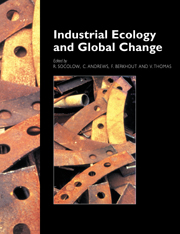Book contents
- Frontmatter
- Contents
- Foreword
- Preface
- Acknowledgments
- Contributors
- OVERVIEW
- PART 1 VULNERABILITY AND ADAPTATION
- PART 2 THE GRAND CYCLES: DISRUPTION AND REPAIR
- PART 3 TOXICS AND THE ENVIRONMENT
- PART 4 INDUSTRIAL ECOLOGY IN FIRMS
- 23 Introduction
- 24 Product Life-Cycle Management to Replace Waste Management
- 25 Industrial Ecology in the Manufacturing of Consumer Products
- 26 Design for Environment: A Management Perspective
- 27 Prioritizing Impacts in Industrial Ecology
- 28 Finding and Implementing Projects that Reduce Waste
- 29 Free-Lunch Economics for Industrial Ecologists
- PART 5 INDUSTRIAL ECOLOGY IN POLICY-MAKING
- END PIECE
- Organizing Committee Members
- Working Groups
- Index
28 - Finding and Implementing Projects that Reduce Waste
Published online by Cambridge University Press: 04 August 2010
- Frontmatter
- Contents
- Foreword
- Preface
- Acknowledgments
- Contributors
- OVERVIEW
- PART 1 VULNERABILITY AND ADAPTATION
- PART 2 THE GRAND CYCLES: DISRUPTION AND REPAIR
- PART 3 TOXICS AND THE ENVIRONMENT
- PART 4 INDUSTRIAL ECOLOGY IN FIRMS
- 23 Introduction
- 24 Product Life-Cycle Management to Replace Waste Management
- 25 Industrial Ecology in the Manufacturing of Consumer Products
- 26 Design for Environment: A Management Perspective
- 27 Prioritizing Impacts in Industrial Ecology
- 28 Finding and Implementing Projects that Reduce Waste
- 29 Free-Lunch Economics for Industrial Ecologists
- PART 5 INDUSTRIAL ECOLOGY IN POLICY-MAKING
- END PIECE
- Organizing Committee Members
- Working Groups
- Index
Summary
Abstract
Success stories are important to share, especially when they contradict the assumptions of simple economic theory. Annual waste reduction contests among employees of the Louisiana Division of The Dow Chemical Company have been held for the past decade. This contest has continued to find significant, highly costeffective energy- and materials-saving projects each year, implying that even wellmanaged firms do not automatically optimize their use of resources. The additional efficiencies squeezed out of the firm's plants suggest that great potential exists to improve the efficiency of the industrial sector, if appropriate leadership is provided and if organizational and other internal barriers can be overcome.
The Louisiana Division Program
Keeping employees interested in saving energy and reducing waste is a constant challenge. Ideally, all employees should be personally committed to a philosophy of continuous improvement. Improving operations should be seen as part of their normal jobs.
The Louisiana Division of The Dow Chemical Company began an energy conservation program in 1981. It took the form of an annual contest for employees to improve energy efficiency. In 1983, the scope of the contest was expanded to include yield improvement, and in 1987, Dow's Waste Reduction Always Pays (WRAP) program was added. The contest has been enormously successful in motivating employees to find ways of saving energy and reducing waste. In the late 1970s and early 1980s many companies jumped on the energy conservation bandwagon and started energy conservation programs. But as energy prices dropped, most of these programs were phased out. The program at Dow's Louisiana Division is an exception. Not only did it not disappear, it is far stronger now than it was ten years ago.
- Type
- Chapter
- Information
- Industrial Ecology and Global Change , pp. 371 - 382Publisher: Cambridge University PressPrint publication year: 1994
- 7
- Cited by



